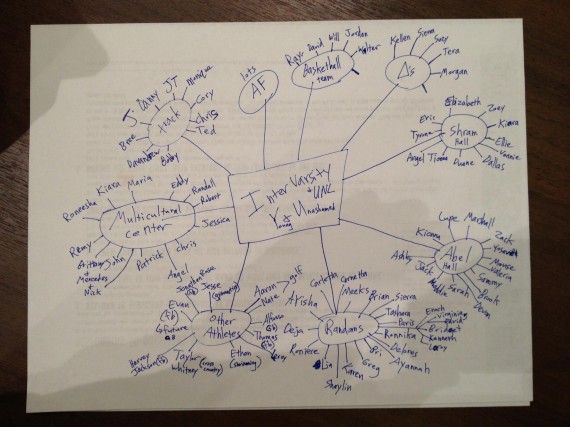
network map of students at Lincoln Nebraska
[This post is part of the Start Something New series. Read the other posts here!]
By Shawn Young
One of the contributing writers on Releasetheape.com is Eric Rafferty. He and his wife Stacey were selected to participate in InterVarsity’s national planting cohort 3 years ago and have launched a thriving student ministry at the University of Nebraska in Omaha. Recently I heard a rumor that Eric had visited another college in Lincoln, NE and managed to launch 3 new missional student communities in one day. Yes. You read that right. In fact, he launched a Black Student Ministry, an International Student Ministry, and a Greek Student Ministry.
I work with hundreds of the most talented ministry leaders in the country and they know how hard it can be to get just one student ministry to launch. So I asked him to speak with me and several other leaders about how it happened. The more Eric talked, the more I realized that we were listening to the pure mojo of a genuine apostolic-evangelistic leader. But I firmly believe that much of what Eric does instinctively can be learned and passed on to all of us—the whole church is strengthened for God’s mission when we learn from examples like Eric and Stacey.
Eric’s Secret Sauce
CLEAR VISION, CLEAR CALL
Eric knows who he’s been sent to reach and what he’s been called to do. He can say it in a sentence, and expand the key points in 5 minutes, and give a full blown 30 minute message on it. And he always asks for people’s response to what he’s shared. He may just ask, “Does that sound like something you’d want to be a part of?” Or if he has a stronger sense that someone is ready to be called or challenged, he’ll ask them to take a specific step that will lead to more involvement. “Why don’t you invite some of your friends to sit down with me and talk more about this…?”
START WITH THE RIGHT GOAL
From the very outset, they were telling people they wanted “to reach every corner of the campus and empower students to start new ministries in their own networks”. This is a bigger vision than simply launching a student group on campus. It’s a subtle, but profound departure from the way many planters think. A lot of college ministers come to campus with the goal of planting a group (or chapter) that they hope will grow to some enormous size that they dream will eventually impact the other 99% of the campus. It has never happened in reality. Even the largest Christian student groups in the country engage less than 5% of their campus in a meaningful way. Eric and Stacey’s vision was big—big enough that a single Christian group would never be adequate. They knew that if they really wanted to reach the whole campus, they would have to do more than plant a chapter—they would need to start a movement.
EVERY PERSON IS PART OF A NETWORK
“I don’t see individuals”, says Eric, “When I look at one person, I see a network”. Although this perspective grinds against the predominant North American individualist mindset, it is actually more holistic and consistent with the way Jesus looked at people. In John 4, the disciples return to find Jesus talking with a woman by a well. They wondered why he would speak with a woman (and a Samaritan at that), but Jesus could see something they couldn’t. He saw her spiritual thirst, and beyond that, the thirst of the entire town that she came from. After encountering Jesus, she immediately goes back to testify to her town, “He told me everything I’ve ever done. Could this be the Messiah?” When he visits them, they beg him not to leave. This is why Jesus says to his disciples, “Open your eyes.. look at the fields—they are ripe for harvest”. The disciples saw a Samaritan woman, but Jesus saw a village that was ready to believe. So Eric is immediately interested in the relational networks behind every individual he meets, and wants to help every Christian become like the Samaritan woman to their “village”. He regularly asks students to chart out their relational networks to see where God might be at work already. When he found some African American students who wanted to reach others on their campus, he asked them to chart their networks together.
“In 10 minutes, they identified over 100 people they knew”.
SCATTER SEEDS LIBERALLY, SEE WHO RESPONDS
Eric is willing to share his vision with every contact that looks like they have even a small possibility of responding. He gets blank stares sometimes, and many times it doesn’t pan out, but he considers this part of the process of locating the “good soil” (Mark 4) people that Jesus was looking for. “You have to be willing to just try with people and see how they react”, says Eric. Often Eric will ask a simple practical question like, “What would you think about starting an outreach in the place/people you are connected with?” If someone responds positively, Eric walks them through what that could look like. If they aren’t interested enough to take the next step, then he simply invites them to join one of the existing groups so they can get a sense of what God is doing. Ultimately, Eric is following the parable of the Sower and the Seed, in that he shares the gospel and the vision to reach the campus liberally, in order to find those who are good soil to work with. And then he commits more time to those who want to start a new Jesus community on campus in their networks. He is looking for those students that will “produce a crop 30, 60 or 100 times what what sown”. So Eric spends most of his time helping missional students start new things. He loves it.
TRAIN APPRENTICES IN THE CONTEXT OF THEIR NETWORKS
Once a student agrees to begin reaching his/her network, Eric wants to meet all their friends. “I’ll meet their friends, interact with them, and I’ll partner with the student to lead a bible study.” That’s where Eric can demonstrate what an interactive, engaging discussion around scripture looks like. He is aware of the Seekers, and can help them think through their questions and next steps toward following Jesus. He keeps asking the simple but crucial question, “Do you have other friends who would want to have something like this?” Soon Eric will turn the leadership of the group completely over to the student and take a coaching role from there. The genius of Eric’s approach is that he’s helping students become the indigenous missionaries to their own networks. He is an activator of missional communities.
Stacey’s Secret Sauce
It’s important to mention that Stacey’s gift is primarily prophet and shepherd. According to their supervisor, “She is extremely good at noticing the deeper discipleship issues—sin, character flaws, relationship problems and moral issues that come up. She calls people on it, and then pastors them through the repentance and healing process”. Without this attention to the soul, the majority of these students would crash and burn as leaders, doing damage to themselves and the people they are trying to influence. Her gifts are absolutely crucial to the entire network of students involved.
[This post is part of the Start Something New series. Read the other posts here!]

Sign up to receive our blog posts via e-mail and get instant access to our APE Library with videos, seminars, leaders notes, and more.


Eric! You are the man! Love the way you think! I want to be like you 🙂 Very encouraging!
Thanks, Beau! It’s a fun adventure to be on!
Thanks for telling our story, Shawn!
This was very helpful and inspiring! zit is too easy to get tunnel vision as we pursue students on campus. It is not about our little thing, but it’s about what God is doing around us!!